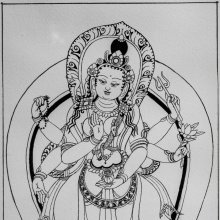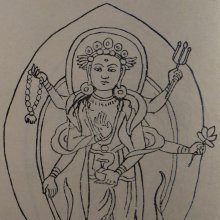Sugatisandarshana, Sugatisandarśana, Sugati-sandarshana, Sugatisaṃdarśana, Sugati-samdarshana, Sugatisamdarshana: 1 definition
Introduction:
Sugatisandarshana means something in Buddhism, Pali. If you want to know the exact meaning, history, etymology or English translation of this term then check out the descriptions on this page. Add your comment or reference to a book if you want to contribute to this summary article.
The Sanskrit terms Sugatisandarśana and Sugatisaṃdarśana can be transliterated into English as Sugatisandarsana or Sugatisandarshana or Sugatisamdarsana or Sugatisamdarshana, using the IAST transliteration scheme (?).
Images (photo gallery)
In Buddhism
Tibetan Buddhism (Vajrayana or tantric Buddhism)
Source: archive.org: The Indian Buddhist Iconography1) Sugatisandarśana (सुगतिसन्दर्शन) or Sugatisandarśanalokeśvara refers to one of the various forms of Avalokiteśvara having their Sādhana described in the 5th-century Sādhanamālā (a collection of sādhana texts that contain detailed instructions for rituals).—His Colour is white; he has six arms.—One short Sādhana in the Sādhanamālā describes this form [viz., Sugatisandarśana] of Avalokiteśvara.
The Dhyāna (meditation instructions) of Sugatisandarśana described in the Sādhanamālā as follows:
“The worshipper should think himself as Bhaṭṭāraka Sugatisandarśana-Lokeśvara white in complexion, six-armed, showing the varada and abhaya poses and the rosary in the three right hands, and carrying the lotus, the water-pot and the staff with three horns in the three left hands. He is decked in ornaments and jewels, wears the sacred thread and a crown of matted hair. He stands on the moon over lotus and is peaceful in appearance”
2) Sugatisandarśana (सुगतिसन्दर्शन) or Sugatisandarśanalokeśvara refers to number 16 of the 108 forms of Avalokiteśvara found in the Machhandar Vahal (Kathmanu, Nepal). [Machhandar or Machandar is another name for for Matsyendra.].
Accordingly,—
“Sugatisandarśana is one-faced and six-armed and stands on a lotus. In his three right hands he carries the rosary and exhibits the Varada and Abhaya poses. The three left have the Tridaṇḍi, the Utpala and the water-pot”.
The names of the 108 deities [viz., Sugatisandarśana] possbily originate from a Tantra included in the Kagyur which is named “the 108 names of Avalokiteshvara”, however it is not yet certain that this is the source for the Nepali descriptions. Tibetan Buddhism includes schools such as Nyingma, Kadampa, Kagyu and Gelug. Their primary canon of literature is divided in two broad categories: The Kangyur, which consists of Buddha’s words, and the Tengyur, which includes commentaries from various sources. Esotericism and tantra techniques (vajrayāna) are collected indepently.
See also (Relevant definitions)
Partial matches: Samdarshana, Sugati.
Starts with: Sugatisamdarshanalokeshvara.
Full-text: Sugatisamdarshanalokeshvara.
Relevant text
Search found 1 books and stories containing Sugatisandarshana, Sugatisandarśana, Sugati-sandarshana, Sugatisaṃdarśana, Sugati-samdarshana, Sugatisamdarshana, Sugati-sandarśana, Sugati-saṃdarśana, Sugatisandarsana, Sugatisamdarsana, Sugati-sandarsana, Sugati-samdarsana; (plurals include: Sugatisandarshanas, Sugatisandarśanas, sandarshanas, Sugatisaṃdarśanas, samdarshanas, Sugatisamdarshanas, sandarśanas, saṃdarśanas, Sugatisandarsanas, Sugatisamdarsanas, sandarsanas, samdarsanas). You can also click to the full overview containing English textual excerpts. Below are direct links for the most relevant articles:
.jpg)

